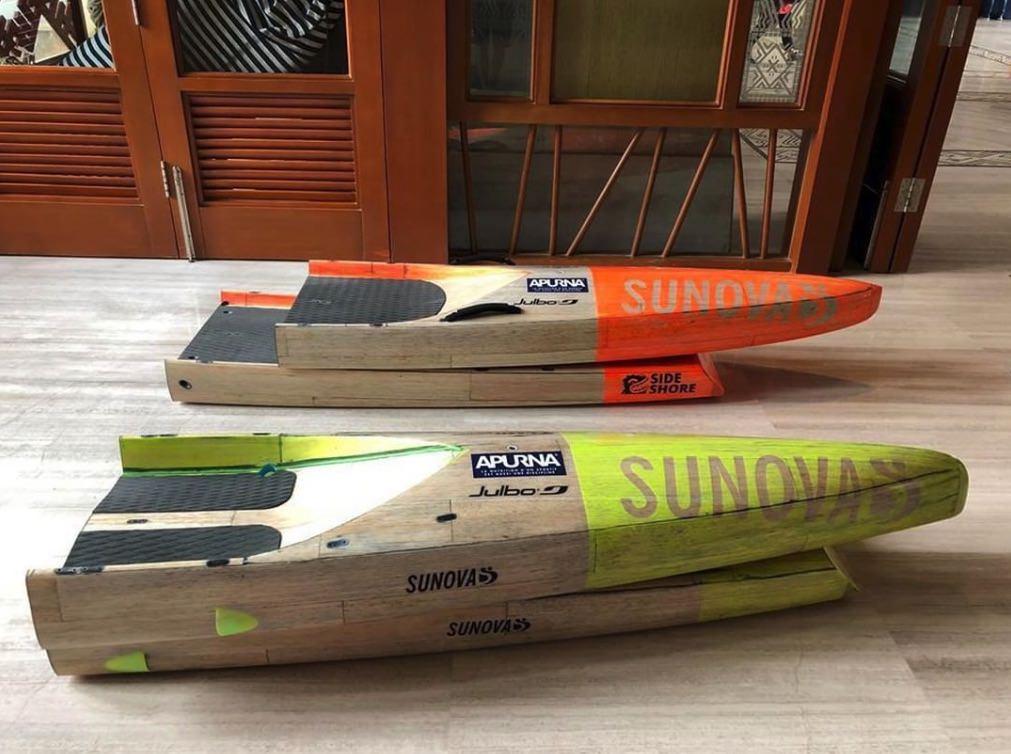Our Technologies!
Everything in one place
Burt Burger: We're licensing it. We signed an exclusive deal with Mike Becker at Carbon Compact.
I think the performance demands of a shortboard and longboard are pretty much the same; flex and the correct rate of power and speed in the spring back will always be the key factor.
Now I will clarify that a bit more, 'cos you have two different schools of longboard surfing these days. Like you've got the crew who gravitate to a performance longboard and use it like a big shortboard, generally bigger guys who struggle to find a good shortboard, or older crew who were once shortboard rippers but now want that paddle power and to smash out some decent turns. So all of the aforementioned will basically be looking for shortboard performance characteristics in their longboards and that means dialing in the magic flex.
Now the crew in the Sunova sales and marketing department will have my balls for this, but I have to state my honest opinion. In both performance short and longboards the concept of the two-piece is a convenience feature, primarily aimed at ease of travel. It's not a performance enhancing feature because it does change the flex, full stop.
No, only for convenience. But logging, SUP, and race SUP are different stories, and I'll explain each, starting with logs.
As someone who has worked with flex for a long time, I've experienced its positive and negative aspects. I've had performance longboards that were mind blowing; so loose and sensitive to pump for speed, you could smash out a vertical turn and bend it into the pocket of a three foot wave, but the very same board was impossible to nose ride, difficult to walk, and it had no glide. The extra flex killed its traditional performance aspects: as you tried to walk, it was bending and warbling, losing speed, then if you got to the nose, it was virtually impossible to get back.
If you want a longboard log that feels stable to walk, keeps its speed while walking and has great glide, it has to be stiffer. So here comes a light bulb moment for you guys. People say a good log has to be heavy, but they say that because a heavier log will be stiff. So it's the stiffness that's the key, not the weight. So the two-piece concept in traditional log-style longboards will have no negative performance aspects.
In surf SUP...well, here you're talking about boards that are four to five inches thick and really wide, so you dont take advantage of flex the same as a performance shortboard. The sheer thickness and size of SUP makes flex a way harder area to dial in, yet what the pro SUP guys are using with crazy light and refined boards, they're taking advantage of what performance surfboards have, so I see no advantage in a two-piece for a pro SUP rider or a guy who rips at a SUP at pro level.
For every other surf SUP, or touring, or flat water board, there's no issue, no negative performance aspects with two-piece boards.
Race SUP?...surprise, surprise! I honestly cant believe how many podiums we have been getting with our two-piece race boards.
The generally accepted theory for a good race SUP is light and stiff. To achieve this every other brand goes for full carbon fiber, yet they lack one important feature: skin or panel flex. This is something unique to Sunova construction and one of the reasons both the surf SUP and surfboards go so well and have such a smooth ride. When you squeeze the bottom of a Sunova you can feel it depress under your thumb, but then spring back to its original position. This gives the board the ability to handle bumps and chop by absorbing and morphing to the chop, then springing back into position.
Full carbon boards don't have this feature, they're rigid and every chop makes the board dance and get buffeted around, which ultimately slows you down. But you need the overall stiffness length-ways in the board as you crash through and over waves or even aggressively take paddle strokes pulling yourself into the board. Any length-ways flex and the rocker will change and slow you down.

So the generally accepted theory is correct, you want it light for faster acceleration, and you want it stiff for glide, but Sunova adds one more element: shock absorption from small chop and bumps via skin flex. And in an effort to get the race boards crazy light, at some point you're going to be dealing with flex issues again. We were already making the standing area stiffer so the rider didnt flex the board, but the two-piece components really add another level of stiffness where you want it. So while there is a subtle weight gain, it goes exactly where people normally add extra weight for stability.
The stiff centre makes them feel solid under foot with great glide. I dare say they may possibly go even better as single piece SUPs, as I'm struggling to account for the amount or races that are getting won on our two-piece boards.
Nah, I wouldn't even consider it. I'm not saying it cant be done, but it would require a total rethink. Even though big wave boards are way stiffer, they still need flex, and that flex needs to be evenly distributed while the two-piece system creates a stiff spot.
If I had to quickly have a thought out loud, it would be to reduce the diameter of the carbon tubes so they flexed then increase their length to distribute that flex. But at this point why do I want to complicate things? It's hard enough as it is getting them right as it is!
This interview was posted by Swellnet.com here: Sunova: A story in two parts by Stu Nettle in Design Outline on Friday, 8 March 2019.